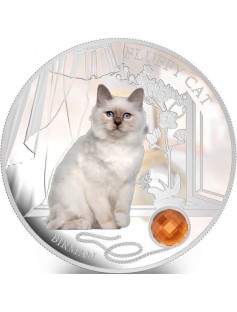- Low mintage limit, only 5,000
- Coin in capsule + with Certificate of Authenticity + BOX
- Fourth coin in Fluffy Cats series
- Coin not issued yet! Be Firt who will get it
- Coin with Swarovski crystal
The Birman, also called the "Sacred Cat of Burma", is a domestic cat breed. It should not be confused with the Burmese, which is a dissimilar breed. The Birman has medium-long hair, a pale colored body with darker points and deep blue eyes. Even though the cat is pointed, the paws have white gloves.
Birmanie is the French spelling of Burma. The Birman breed was first recognized in France by the Cat Club de France in 1925, then in England by the Governing Council of the Cat Fancy (GCCF) in 1966 and in United States by the Cat Fanciers' Association (CFA) in 1967. It is also recognized by the Canadian Cat Association (CCA), and by The International Cat Association (TICA) in 1979.
There is no clear record of the origin of Birmans, but one unsourced but oft repeated legend is that the Birman cat originated in Burma where they were kept by temple priests in Northern Burma in the Mount of Lugh. This is repeated as ...Auguste Pavie and Major Gordon Russell, a British officer (reportedly fictitious), received a pair of temple cats from the Temple of Lao-Tsun (The Abode of the Gods ), situated East of Lake Incaougji (Indawgyi Lake), between Magaoung (Mogaung) and Sembo (Shwebo). This legend is attributed to the writings of Mme Marcelle Adam (novelist and president of the Federation Feline Française and owner of Maldapour Birman Cattery) and first published by Dr. François Méry in the French Review Minerva.[citation needed] There are many colorful stories of how the cats first came to France, including pairs of cats being a reward for helping defend a temple, or being smuggled out of Burma by a Vanderbilt. There is also a story that a couple of stolen birmans (or a pregnant female called Poupée de Maldapour) were imported to France by Thadde Haddisch.
The first traces of historical Birmans go back to a Mme Leotardi in the city of Nice in France.
Birmans were almost wiped out as a breed during World War II. Only two cats were alive in Europe at the end of the war, a pair named Orloff and Xenia de Kaabaa, both belonging to Baudoin-Crevoisier. The foundation of the breed in postwar France were offspring of this pair. They had to be heavily outcrossed with long-hair breeds such as Persian and Siamese to rebuild the Birman breed. By the early 1950s, pure Birman litters were once again being produced. The restored breed was recognized in Britain in 1965 and by the CFA in 1966.[citation needed]
The first Birman cats were seal-point. The Blue-point color was introduced in 1959 using Blue Persian lines. New colors were added by the work of English Breeders in the 1970-1980 including chocolate, red-point, and the tabby/lynx version.[citation needed] A Birman was also used to create new breeds like the Ragdoll cat in California.






